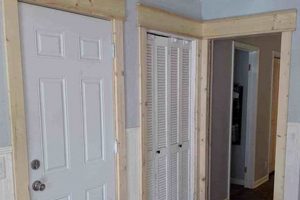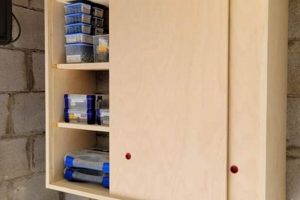Constructing a space-saving and aesthetically pleasing entrance involves a specialized type of door system. This system combines the space-saving functionality of folding doors with the rustic charm of barn door aesthetics. This specific construction project allows homeowners to customize elements such as material, size, and finish, resulting in a unique architectural feature. An example would be replacing a traditional swinging door in a small bathroom with a handcrafted, folding access point made from reclaimed wood.
The appeal of this building choice lies in its dual advantages: optimizing limited square footage and introducing a personalized design element. Historically, barn doors served practical purposes in agricultural settings, but their adaptation into interior design offers a blend of functionality and visual interest. This combination enhances the value and character of a living space by maximizing usable area and incorporating a distinctive focal point.
Subsequent discussion will elaborate on the necessary materials, essential tools, and a step-by-step procedure for undertaking this project. Furthermore, it will explore common challenges encountered during the building process, providing effective solutions and preventative measures for ensuring a successful outcome.
Construction Guidance
The following recommendations are provided to optimize the fabrication process, ensuring structural integrity and aesthetic appeal. Strict adherence to these guidelines contributes to a durable and visually cohesive finished product.
Tip 1: Material Selection: Prioritize the selection of high-quality lumber appropriate for both folding mechanisms and barn door aesthetics. Softwoods, such as pine, offer ease of workability but require protective finishes. Hardwoods, like oak, provide increased durability but demand more specialized tooling.
Tip 2: Accurate Measurement: Precise measurements of the door opening are crucial. Account for track hardware, folding clearances, and any potential obstructions. Deviation from accurate measurements can result in functional impediments and aesthetic discrepancies.
Tip 3: Hardware Compatibility: Ensure the selected track system, hinges, and associated hardware are compatible with the weight and dimensions of the constructed doors. Incompatible hardware can lead to premature wear, structural failure, or operational malfunctions.
Tip 4: Secure Fastening: Employ appropriate fastening methods, such as screws, bolts, and adhesives, to secure all components. Predrilling pilot holes prevents wood splitting, particularly when working with hardwoods. Proper fastening ensures structural stability and longevity.
Tip 5: Precise Alignment: During assembly, maintain precise alignment of all folding panels and track components. Misalignment can impede smooth operation and contribute to uneven wear patterns. Utilize levels and squares to ensure accurate alignment during installation.
Tip 6: Smooth Operation: Verify smooth and unobstructed operation of the folding mechanism after assembly. Lubricate all moving parts to minimize friction and prevent binding. Address any operational issues promptly to avoid future complications.
Tip 7: Finish Application: Apply a durable finish to protect the wood from moisture, UV exposure, and physical damage. Consider the desired aesthetic and select a finish that complements the overall design. Proper finish application enhances longevity and visual appeal.
Implementing these strategies contributes to a robust and visually pleasing entryway system, blending functionality with personalized aesthetics. Attention to detail during each phase is critical for a successful outcome.
The subsequent section will address common challenges encountered during construction and strategies for resolving them.
1. Hardware
The selection and integration of appropriate hardware is paramount to the functionality and longevity of this door project. Hardware components encompass the track system, hinges, rollers, guides, and fasteners. The track system dictates the smooth movement of the doors along the horizontal plane, requiring robust construction to support the weight of the door panels. Hinges facilitate the folding action, necessitating durable materials and precise alignment. An undersized or poorly designed track system will cause binding, difficulty in operation, and potential structural failure. Similarly, inadequate hinges will lead to sagging, misalignment, and compromised folding functionality.
For instance, a project using heavy, solid wood panels demands a heavy-duty track system with rollers rated for the corresponding weight. In contrast, a lightweight door constructed from composite materials can utilize a less substantial, and consequently, less expensive hardware setup. The spacing and type of fasteners used to secure the track to the wall studs and the hinges to the door panels directly impacts stability and safety. Improperly secured hardware jeopardizes the entire installation, creating a potential hazard. Consider the real-world example of a residential install where the track system was not properly attached to the wall studs resulting in the entire door assembly detaching from the wall.
In conclusion, hardware components are not merely accessories; they are integral elements of a customized entrance. The correct choice, installation, and maintenance of these components directly affect operational efficacy, structural integrity, and the overall aesthetic appeal of the installation. Neglecting hardware considerations can result in project failure, highlighting the importance of careful planning and execution. A comprehensive understanding of hardware specifications is essential to overcoming challenges.
2. Measurements
Accurate measurements are paramount to the success of any endeavor involving a customized entrance. Erroneous dimensions can lead to significant functional and aesthetic issues. This precision is not merely a suggestion; it constitutes a fundamental prerequisite for achieving a properly operating and visually harmonious completed structure. These dimensions will directly effect the cost and the total project time.
Consider the scenario where the door opening is measured incorrectly, resulting in a door panel that is either too wide or too narrow. A panel that is too wide will impede the folding action, causing the door to bind against the adjacent wall or frame. Conversely, a panel that is too narrow will create unsightly gaps, compromising privacy and potentially affecting energy efficiency. Furthermore, improper measurement of the track length can lead to operational problems. An inadequate track length restricts the door’s ability to fully open, while an excessive length introduces unnecessary visual clutter. The hinges must also be correctly measured on both sides of the door to allow for proper closing.
In conclusion, precision is not merely an ideal; it’s an operational necessity. Accurate measurements dictate the form and function of the final product. Investing time and effort into meticulous measurement practices mitigates the risk of costly errors, streamlines the construction process, and ultimately ensures the success of the project.
3. Material
Material selection constitutes a pivotal decision in the creation of any customized entrance, fundamentally influencing both the aesthetic character and structural integrity of the finished product. The choice of material extends beyond mere visual preference; it dictates the door’s durability, weight, ease of workability, and ultimately, its long-term performance. This selection should be the product of careful consideration, balancing design aspirations with practical requirements.
- Wood Species and Characteristics
The selection of wood species impacts not only the visual appeal but also the structural properties of the doors. Softwoods like pine offer ease of workability and affordability, while hardwoods such as oak provide superior durability and resistance to wear. The grain pattern, color, and texture of the wood contribute significantly to the door’s aesthetic, allowing for customization to complement the existing interior design. The selection of wood also impacts finishing processes. Example: A rustic design might favor reclaimed wood, while a contemporary aesthetic may call for the clean lines of maple.
- Composite Materials and Alternatives
Beyond solid wood, composite materials, such as medium-density fiberboard (MDF) and plywood, present viable alternatives. MDF offers a smooth, uniform surface suitable for painting, while plywood provides enhanced dimensional stability compared to solid wood, reducing the risk of warping or cracking. These materials often present a more cost-effective option and can be particularly advantageous for larger installations where weight is a concern. Example: Exterior grade plywood can be used to prevent rot if the doors are used on an exterior opening.
- Hardware Compatibility and Material Weight
The weight of the chosen material directly affects the required hardware and track system. Heavier materials necessitate robust hardware capable of supporting the load, while lighter materials allow for the use of less substantial components. Incompatible hardware can lead to premature wear, operational difficulties, and potential safety hazards. Careful consideration of material weight and hardware compatibility is therefore crucial for ensuring smooth and reliable operation. Example: a solid oak build would require stronger hinges.
- Environmental Considerations and Sustainability
The choice of material should also reflect environmental awareness. Opting for sustainably sourced wood, reclaimed materials, or low-VOC finishes minimizes the environmental impact of the project. Considering the entire life cycle of the material, from its origin to its eventual disposal, promotes responsible and sustainable building practices. Example: Sourcing wood from forests with replanting programs.
Ultimately, the selection of materials plays a vital role in determining the success and longevity of a diy bifold barn doors project. By carefully evaluating the characteristics, compatibility, and environmental impact of various materials, one can create a customized entrance that is both aesthetically pleasing and structurally sound. The selected material should then match any pre-existing hardware that is in place.
4. Assembly
The assembly phase in creating a customized access point represents a critical juncture where individual components converge into a functional unit. Assembly, in this context, signifies the systematic joining of door panels, hinges, track hardware, and any decorative elements to form the completed door system. The precision and accuracy of this phase directly determine the operational efficiency and structural integrity of the resulting installation. For instance, misaligned hinges will inevitably lead to binding, impeding smooth folding and potentially causing premature wear or even structural failure. Similarly, improperly secured track hardware compromises the stability of the entire system, posing a safety hazard.
Successful assembly relies upon a thorough understanding of the chosen design, a meticulous approach to component alignment, and the application of appropriate fastening techniques. Each connection point must be addressed with careful attention, ensuring proper spacing, secure attachment, and smooth operation. A real-world example highlighting the importance of this stage involves a scenario where door panels were not assembled with a perfectly square alignment. This seemingly minor deviation resulted in the entire system becoming difficult to open and close, eventually requiring complete disassembly and reassembly. Correct assembly also plays a vital role in the long term maintenance of this project.
In summary, the assembly phase is more than just putting pieces together; it’s a critical step that dictates the overall success of the project. Adherence to precise alignment, secure fastening, and a comprehensive understanding of the design are paramount. Overlooking these factors can lead to operational difficulties, structural instability, and a compromised final product. A poorly assembled system undermines the potential benefits of customization, emphasizing the need for diligent execution throughout this critical phase.
5. Installation
The installation phase represents the culmination of efforts in constructing a customized entryway, demanding precision and adherence to established guidelines. It is during this stage that the assembled door system is integrated into the intended architectural space, determining its functionality, stability, and overall aesthetic impact. Proper installation ensures smooth operation, prevents premature wear, and mitigates potential safety hazards.
- Structural Integrity and Support
Successful installation hinges on the adequacy of the supporting structure. Wall studs must be properly located and capable of bearing the weight of the door and track system. Reinforcement may be necessary, particularly in older homes or when working with heavier materials. Example: Failure to adequately secure the track to wall studs can result in the entire door assembly detaching from the wall, posing a significant safety risk.
- Track Alignment and Leveling
Precise alignment and leveling of the track are critical for smooth and effortless door operation. Deviations from true horizontal or vertical can cause binding, uneven wear, and difficulty in opening and closing the doors. Utilizing a level and shims during installation ensures proper alignment. Example: A track that is not perfectly level will cause the doors to drift open or closed on their own.
- Hardware Mounting and Security
Secure mounting of all hardware components, including hinges, rollers, and guides, is essential for stability and longevity. Fasteners must be appropriately sized and tightened to prevent loosening over time. Inspecting the hardware and checking screws at regular intervals is the final step of quality control. Example: Loose rollers can cause the door to jump off the track, while improperly secured hinges can lead to sagging or misalignment.
- Clearance and Operational Range
Sufficient clearance must be maintained around the door opening to allow for unobstructed operation. Obstructions such as trim, furniture, or light fixtures can impede the door’s movement, compromising its functionality. Verification of adequate clearance throughout the full range of motion is crucial. Example: Failure to account for the swing radius of the bifold panels can result in the door colliding with adjacent objects.
The installation phase directly impacts the long-term performance and user satisfaction of a diy bifold barn doors project. By prioritizing structural integrity, track alignment, hardware security, and operational clearance, a homeowner can ensure a safe, functional, and aesthetically pleasing entryway that enhances the value and enjoyment of their living space.
6. Finishing
The application of finishing techniques to diy bifold barn doors extends beyond mere aesthetic enhancement; it constitutes a critical process that influences both the longevity and performance of the installed system. A well-executed finish protects the underlying material from environmental factors, enhances its visual appeal, and contributes to the overall value of the project.
- Protection Against Environmental Factors
Finishing provides a crucial barrier against moisture, ultraviolet radiation, and physical abrasion. Unfinished wood, for example, is susceptible to warping, cracking, and decay when exposed to humidity and temperature fluctuations. A durable finish, such as a polyurethane coating, seals the wood surface, preventing moisture absorption and minimizing the risk of damage. Exterior applications, in particular, necessitate finishes with UV inhibitors to prevent fading and degradation of the wood fibers. Example: a properly applied exterior stain will repel water.
- Enhancement of Aesthetic Appeal
Finishing allows for customization of the door’s appearance to complement the surrounding decor. Stains, paints, varnishes, and waxes can be used to achieve a wide range of colors, textures, and sheens. Staining enhances the natural grain patterns of wood, while painting provides a uniform color finish. The choice of finish depends on the desired aesthetic and the characteristics of the underlying material. Example: A matte finish creates a subtle, understated look, while a gloss finish provides a reflective, high-impact appearance.
- Improvement of Cleanability and Maintenance
Finished surfaces are easier to clean and maintain compared to unfinished surfaces. A smooth, sealed finish prevents dirt, dust, and grime from penetrating the material, allowing for easy cleaning with a damp cloth. This reduces the need for harsh cleaning chemicals and prolongs the lifespan of the door. Example: A painted surface can be wiped clean, while an unfinished wood surface may require specialized cleaning products and techniques.
- Contribution to Structural Integrity
Certain finishing techniques can enhance the structural integrity of diy bifold barn doors. For example, applying a wood hardener before finishing can strengthen soft or porous wood, improving its resistance to dents and scratches. Similarly, sealing the end grain of wood prevents moisture absorption and reduces the risk of splitting. Example: Applying a sealant to the end grain of a door panel can prevent moisture from seeping into the wood and causing it to warp.
In summary, the finishing process is an integral component of a diy bifold barn doors project, extending beyond superficial aesthetics to encompass crucial aspects of protection, enhancement, and preservation. Careful consideration of the appropriate finishing techniques and materials ensures a long-lasting and visually appealing entryway that enhances the value and enjoyment of the space. An effective finishing touch can provide structural support and stability.
7. Functionality
Functionality, in the context of diy bifold barn doors, represents the practical and operational effectiveness of the completed system. It encompasses ease of use, space optimization, and the overall contribution to the intended purpose of the designated area. The door must operate smoothly and reliably while fulfilling specific spatial requirements.
- Space Optimization
The primary functional advantage of bifold barn doors lies in their space-saving design. Unlike traditional swinging doors, which require a wide arc of clearance, bifold configurations fold inward, minimizing the encroachment on usable floor area. This feature is particularly valuable in confined spaces, such as bathrooms, closets, or hallways, where maximizing square footage is paramount. For example, a narrow hallway benefits significantly from the installation of such a system, allowing for unrestricted passage and utilization of space that would otherwise be consumed by a swinging door.
- Accessibility and Operability
A functional system provides ease of access and effortless operation for all users. Smooth gliding mechanisms, properly aligned hinges, and user-friendly hardware contribute to a seamless opening and closing experience. The system should require minimal effort to operate, accommodating individuals with varying levels of physical strength and dexterity. For instance, the implementation of high-quality rollers and a well-designed track system ensures that the door glides smoothly and silently, regardless of its size or weight.
- Durability and Longevity
Functionality extends to the long-term performance and resilience of the access point. Durable materials, robust construction, and protective finishes contribute to a system that withstands daily use and resists wear and tear. A functional system maintains its operational integrity over time, requiring minimal maintenance and repair. Consider the installation of solid wood panels and heavy-duty hardware, which ensures that the door withstands repeated use and resists damage from impact or environmental factors.
- Adaptability and Configuration
A functional design allows for adaptability to diverse architectural settings and specific user needs. The system can be configured to accommodate varying door widths, heights, and opening directions. Customization options, such as adjustable hinges and track systems, enable fine-tuning of the door’s operation to optimize its functionality within a particular space. For example, the installation of a bifold system in an unconventional doorway necessitates the ability to adjust the door’s alignment and range of motion to ensure proper operation and aesthetic integration.
These facets collectively contribute to the overall functional performance of diy bifold barn doors. By prioritizing space optimization, accessibility, durability, and adaptability, the construction of this access point enhances the usability and aesthetic appeal of any interior space, exemplifying the harmonious fusion of form and function.
Frequently Asked Questions
The following addresses common inquiries regarding the construction and installation of customized folding entrances. These responses aim to provide clarity and guidance based on established practices.
Question 1: What are the primary space-saving advantages?
The folding design requires significantly less clearance compared to traditional swinging doors. This is particularly beneficial in confined spaces, enhancing usable square footage.
Question 2: What material is most suitable for humid environments?
Weather-resistant materials such as treated wood or composite materials are recommended to prevent warping, swelling, or decay in humid environments.
Question 3: What type of hardware should be selected?
Hardware selection depends on door weight and material. Heavy-duty track systems and hinges rated for the specific door weight are crucial for smooth and reliable operation.
Question 4: Is professional installation necessary?
While DIY installation is possible, professional installation is recommended for ensuring structural integrity, proper alignment, and safe operation, particularly with heavier door systems.
Question 5: How can noise reduction be improved?
Installing soundproofing materials within the door panels or adding weather stripping around the perimeter can enhance noise reduction. Solid-core materials also offer better sound dampening.
Question 6: What maintenance is required?
Periodic lubrication of moving parts, inspection of hardware connections, and occasional cleaning are necessary to maintain smooth operation and prevent premature wear.
Key takeaway: Proper material selection, hardware compatibility, and precise installation are vital for creating a durable and functional entryway.
The next article section will address safety considerations involved in the construction process.
diy bifold barn doors Conclusion
The preceding analysis has addressed the multifaceted considerations involved in creating a customized entrance, encompassing design, material selection, assembly, installation, functionality, and maintenance. Adherence to established practices in each of these areas is essential for achieving a durable and aesthetically pleasing result. The integration of space-saving design with personalized aesthetics presents a unique opportunity to enhance the value and character of interior spaces.
The fabrication and implementation of diy bifold barn doors demand careful planning and execution. Proper diligence ensures structural integrity, long-term functionality, and user safety. As design trends evolve and spatial requirements change, understanding the fundamentals of these installations remains crucial for informed decision-making and successful project completion.







